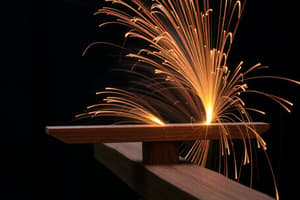Podcast
Questions and Answers
A uniform rectangular block is placed on an adjustable inclined plane. As the angle of the plane is gradually increased, what determines the critical angle at which the block will topple?
A uniform rectangular block is placed on an adjustable inclined plane. As the angle of the plane is gradually increased, what determines the critical angle at which the block will topple?
- The height of the block.
- The location of the block's center of gravity relative to the base. (correct)
- The coefficient of static friction between the block and the plane.
- The weight of the block.
A tall, narrow vase and a short, wide bowl are both sitting on a table. Which of the following adjustments would make the vase more stable and the bowl less stable?
A tall, narrow vase and a short, wide bowl are both sitting on a table. Which of the following adjustments would make the vase more stable and the bowl less stable?
- Raising the center of gravity of the vase and widening the base of the bowl.
- Lowering the center of gravity of the vase and widening the base of the bowl.
- Raising the center of gravity of the vase and narrowing the base of the bowl.
- Lowering the center of gravity of the vase and raising the center of gravity of the bowl. (correct)
An object is in stable equilibrium. What happens when it is slightly displaced?
An object is in stable equilibrium. What happens when it is slightly displaced?
- It continues to move away from its original position.
- It returns to its original position. (correct)
- It moves to a new equilibrium position.
- It remains in the displaced location.
A cube is resting on a flat surface. If you gently push the top edge of the cube, what factor would determine whether it returns to its original position or topples over?
A cube is resting on a flat surface. If you gently push the top edge of the cube, what factor would determine whether it returns to its original position or topples over?
A unicyclist maintains balance by constantly adjusting their center of gravity. How does the unicyclist utilize principles of equilibrium to avoid falling?
A unicyclist maintains balance by constantly adjusting their center of gravity. How does the unicyclist utilize principles of equilibrium to avoid falling?
A mechanic is trying to loosen a bolt. Which action will produce the greatest turning effect (moment) on the bolt?
A mechanic is trying to loosen a bolt. Which action will produce the greatest turning effect (moment) on the bolt?
A see-saw is perfectly balanced. If a heavier person sits on one side, what must happen to re-establish equilibrium?
A see-saw is perfectly balanced. If a heavier person sits on one side, what must happen to re-establish equilibrium?
A uniform beam is pivoted at its center. A weight is placed on the left side of the beam. What single action can restore the beam to a horizontal equilibrium?
A uniform beam is pivoted at its center. A weight is placed on the left side of the beam. What single action can restore the beam to a horizontal equilibrium?
An object is in equilibrium. Which statement MUST be true?
An object is in equilibrium. Which statement MUST be true?
A seesaw has two people sitting on it. Person A is twice as heavy as Person B. To balance the seesaw, how should they position themselves relative to the pivot?
A seesaw has two people sitting on it. Person A is twice as heavy as Person B. To balance the seesaw, how should they position themselves relative to the pivot?
An irregularly shaped object is suspended from a point. How can you determine its center of gravity?
An irregularly shaped object is suspended from a point. How can you determine its center of gravity?
A force of 20 N is applied to a wrench at a distance of 0.3 meters from the bolt. If the force is applied at an angle of 60 degrees to the wrench, what is the magnitude of the torque (moment) applied to the bolt?
A force of 20 N is applied to a wrench at a distance of 0.3 meters from the bolt. If the force is applied at an angle of 60 degrees to the wrench, what is the magnitude of the torque (moment) applied to the bolt?
A tightrope walker uses a long pole to maintain balance. Which principle best explains how the pole helps?
A tightrope walker uses a long pole to maintain balance. Which principle best explains how the pole helps?
Flashcards
Center of Gravity (CG)
Center of Gravity (CG)
The point where the entire weight of an object appears to act. It's at the object's geometrical center.
Stability
Stability
A measure of how well an object maintains its original position after being tilted.
Line of Action and Stability
Line of Action and Stability
For an object to be stable, an imaginary vertical line from its CG must fall within its base area.
Stable Equilibrium
Stable Equilibrium
Signup and view all the flashcards
Unstable Equilibrium
Unstable Equilibrium
Signup and view all the flashcards
What is a moment?
What is a moment?
Signup and view all the flashcards
How do you calculate a moment?
How do you calculate a moment?
Signup and view all the flashcards
What is the unit for moments?
What is the unit for moments?
Signup and view all the flashcards
Steps to find the moment
Steps to find the moment
Signup and view all the flashcards
Principle of Moments
Principle of Moments
Signup and view all the flashcards
Conditions for Equilibrium
Conditions for Equilibrium
Signup and view all the flashcards
Centre of Gravity
Centre of Gravity
Signup and view all the flashcards
Equilibrium and Centre of Gravity
Equilibrium and Centre of Gravity
Signup and view all the flashcards
Study Notes
Turning Effect of Forces
- The turning effect of a force about a point is the product of the force and the perpendicular distance from the point to its line of action.
- This turning effect is also known as 'moment' or 'torque'.
- Moment = F x d, where d refers to the perpendicular distance.
- Moments can be clockwise or anticlockwise.
- The unit for moment is Nm (newton meter).
Finding the Moment
- Draw the line of action of force.
- Connect the line to the pivot.
- Ensure the line is perpendicular.
Principle of Moments
- When an object is in equilibrium, the sum of clockwise moments about a point is equal to the sum of anticlockwise moments about the same point.
- Conditions for Equilibrium of an Object:
- Resultant force acting on it is zero.
- Resultant moment about a pivot is zero.
Centre of Gravity
- The point through which the whole weight of an object appears to act.
- An object balances in equilibrium if the point of balance is directly below its center of gravity.
- The C.G. of any uniform/regular object is at its geometrical center.
- If the pivot is not at the C.G., the sum of clockwise moments will not equal the sum of anticlockwise moments.
- A helicopter tilts down when lift force from front rotor decreases, while lift force from back rotor increases, but its CG stays at the same height.
- The CG of an object is located where most of its mass is concentrated. This exerts a clockwise moment to counter the anticlockwise moment caused by a suspended weight.
Stability
- Stability: A measure of a body's ability to maintain its original position after being tilted.
- For stability, the line of action must fall within the base area.
- Stability is increased by lowering the center of gravity and increasing the base area.
- An object with a lower CG and larger base area requires a larger angle of tilt before the line of action falls outside the base area, making it more stable.
Types of Equilibrium
- Stable Equilibrium: An object returns to its original position after being slightly displaced.
- Limiting Equilibrium: The maximum orientation of an object before it topples.
- Unstable Equilibrium: An object continues to move away from its original position.
- Neutral Equilibrium: An object remains where it is displaced.
- When in neutral equilibrium, tilting the object further causes the line of action of weight to move outside the base area, creating a resultant clockwise moment that causes it to tilt over.
Studying That Suits You
Use AI to generate personalized quizzes and flashcards to suit your learning preferences.




